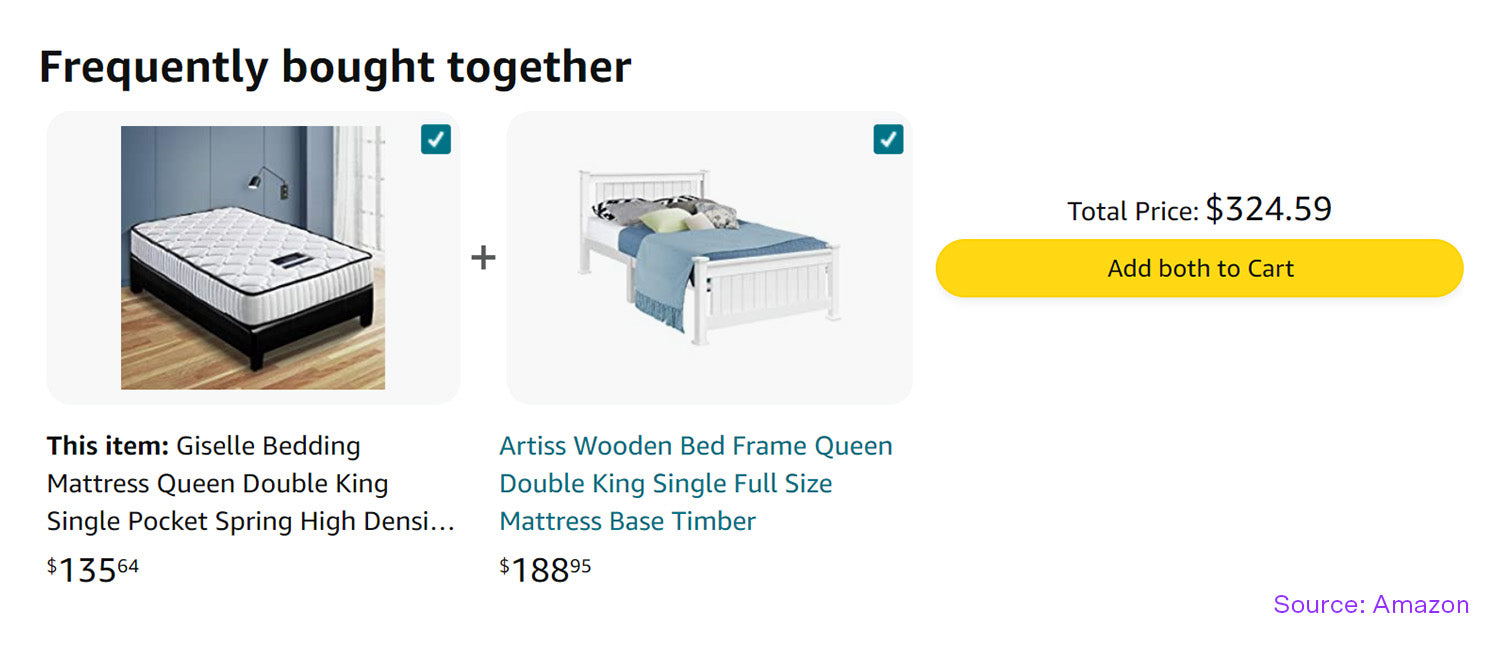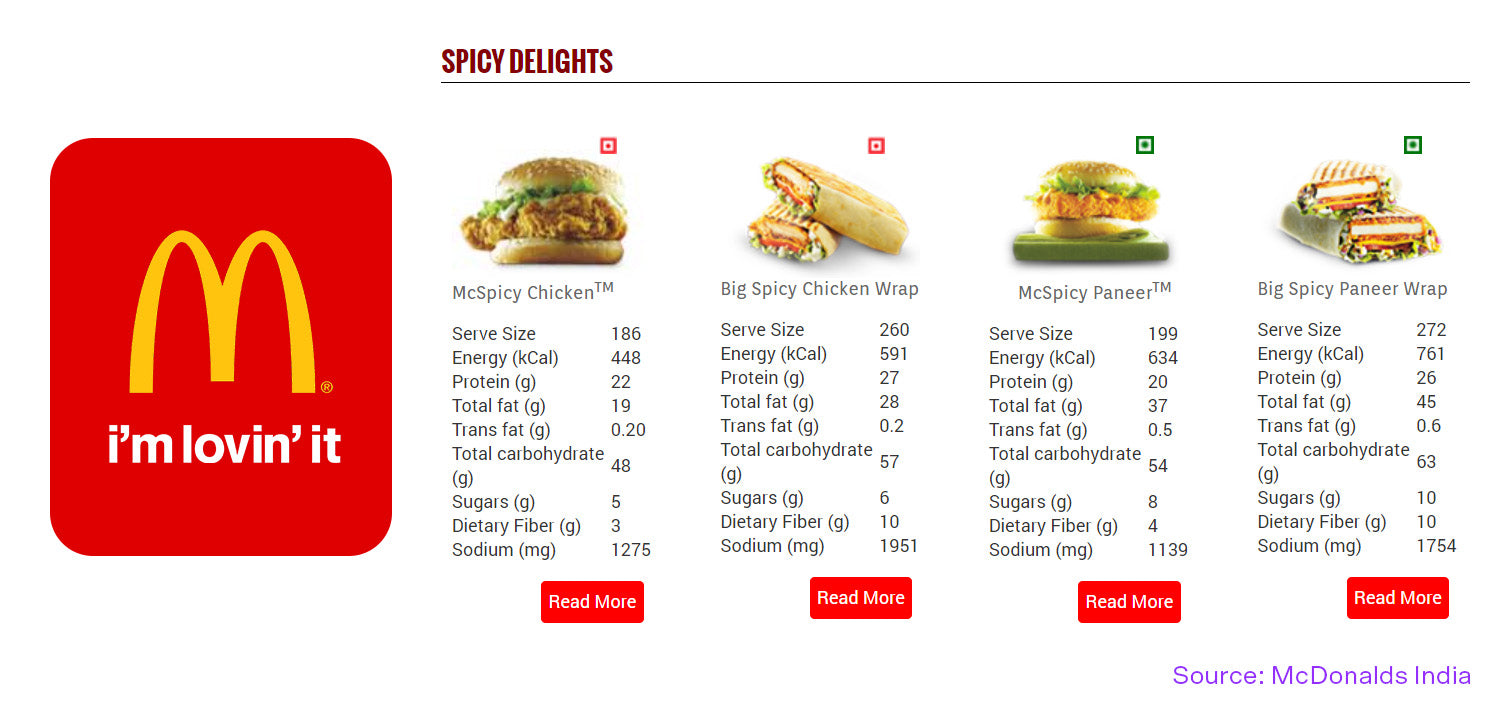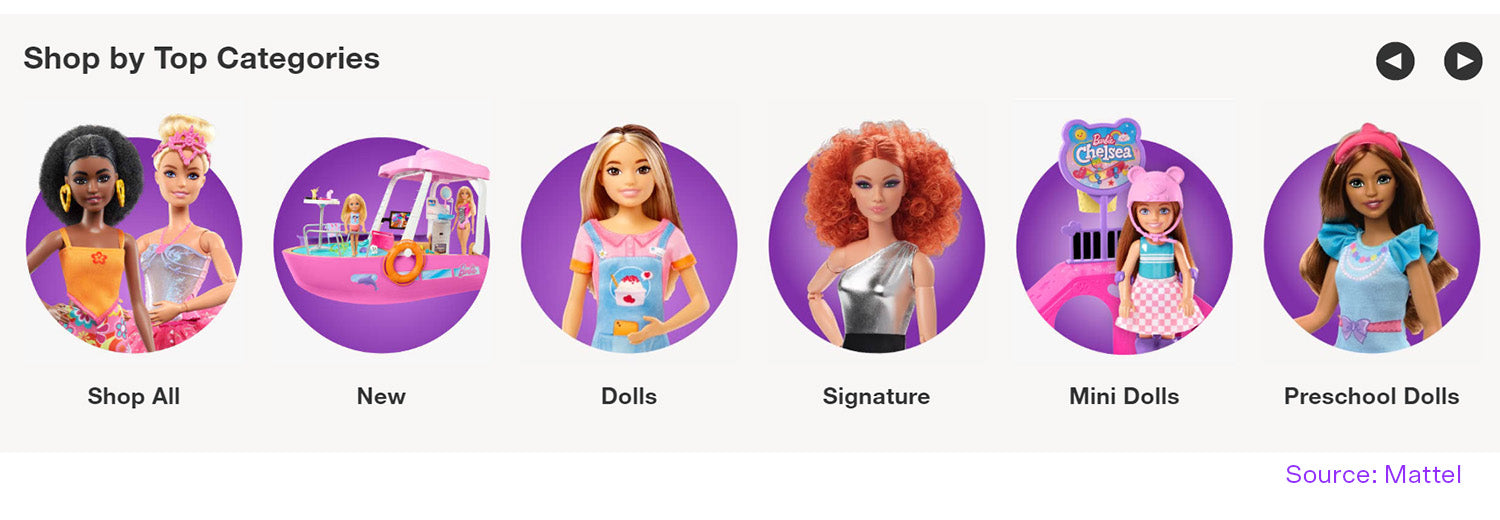
What is Market Segmentation?
Market segmentation is a marketing process that divides your entire market into smaller, more manageable groups. These groups are based on shared characteristics such as age, budget, priorities, past purchases, or other common behaviours.
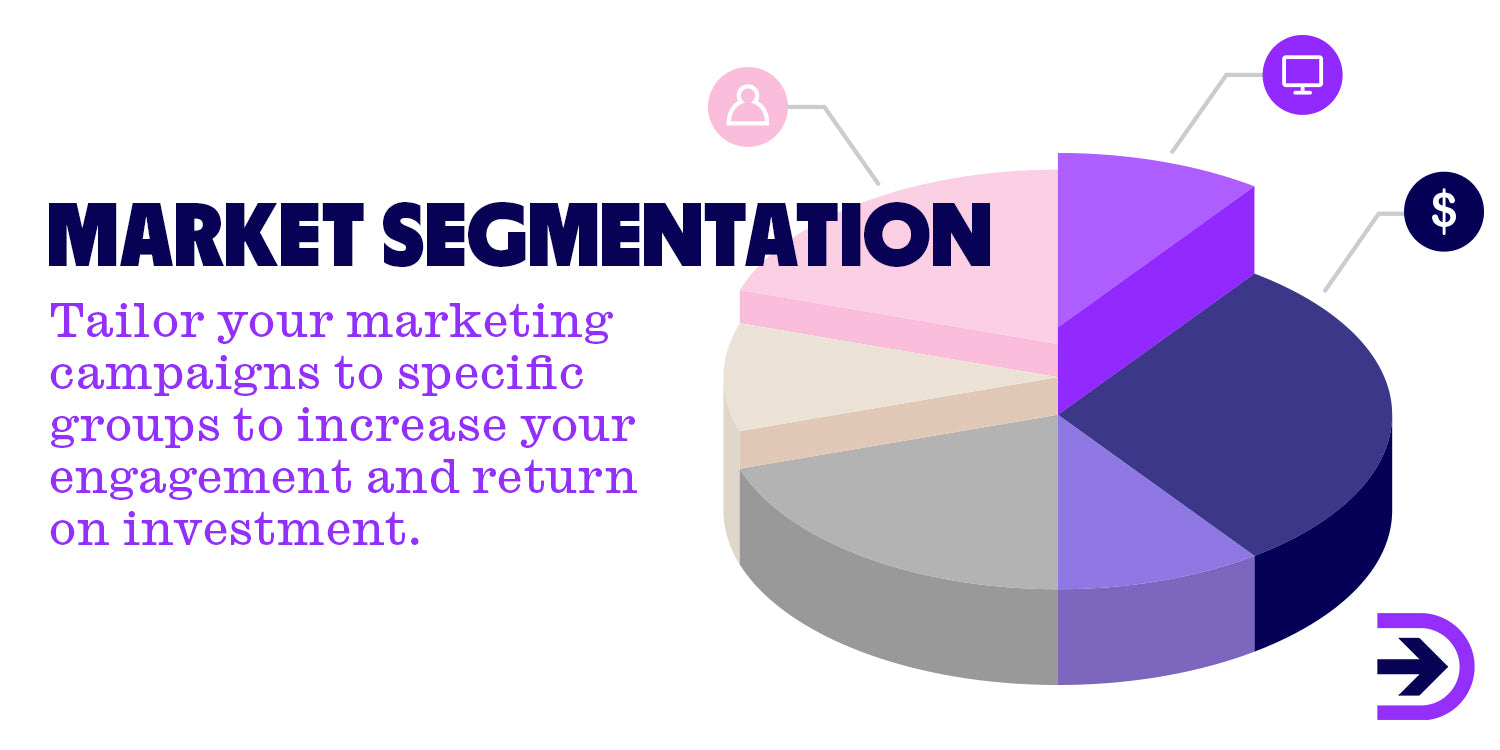
The goal of this process is to better understand your audience and find the right target market for your products. You can use it to tailor your campaigns to specific groups, increasing the chances of engagement and ultimately improving your ROI.
Making blanket assumptions about your target audience is not a viable marketing strategy. If you want to stay ahead of your competitors, read on and find out how market segmentation can work for your business.
The basics of market segmentation
Market segmentation can not only help companies target potential customers, but it can also help identify high-performing products. Companies can use this to find the best ways to market and deliver them to target audiences. We do this by identifying the needs and preferences of customers, using these to define marketing objectives and strategies, and potentially identifying gaps in the market.
There are a number of benefits to market segmentation:
Increase engagement with personalisation
The customer experience doesn’t start and stop with buying a product or service. In fact, 80 per cent of customers find the experiences provided by a company are just as important. Customer expectations are high, and personalised marketing can help you tailor the perfect campaign for higher customer satisfaction, more customer brand loyalty, and better conversion, engagement and retention.
Streamlining mass customisation
Creating personalised campaigns is becoming easier as more technologies are developed to help segment markets. With AI and algorithms becoming more sophisticated, it won’t be long before these processes can be automated.
More cost-efficient campaigns
A great marketing campaign needs the right audience to succeed. With market segmentation, you can make your campaigns more effective, saving you from making costly mistakes.
Identify hidden and niche markets
Data analysis from market segmentation may lead you to discover a new market that you hadn’t previously considered. You’ll have the opportunity to target an entirely new market with untapped potential.
Stronger brand image
In an increasingly competitive digital space, it’s never been more crucial for brands to stand out. Customers usually have a brand in mind when they seek a product. Having a strong brand image gets you in their heads before they even get online. Strong brands will have more effective marketing outcomes, higher acquisition and retention rates, and sustainable growth in the long term.
The four major market segments
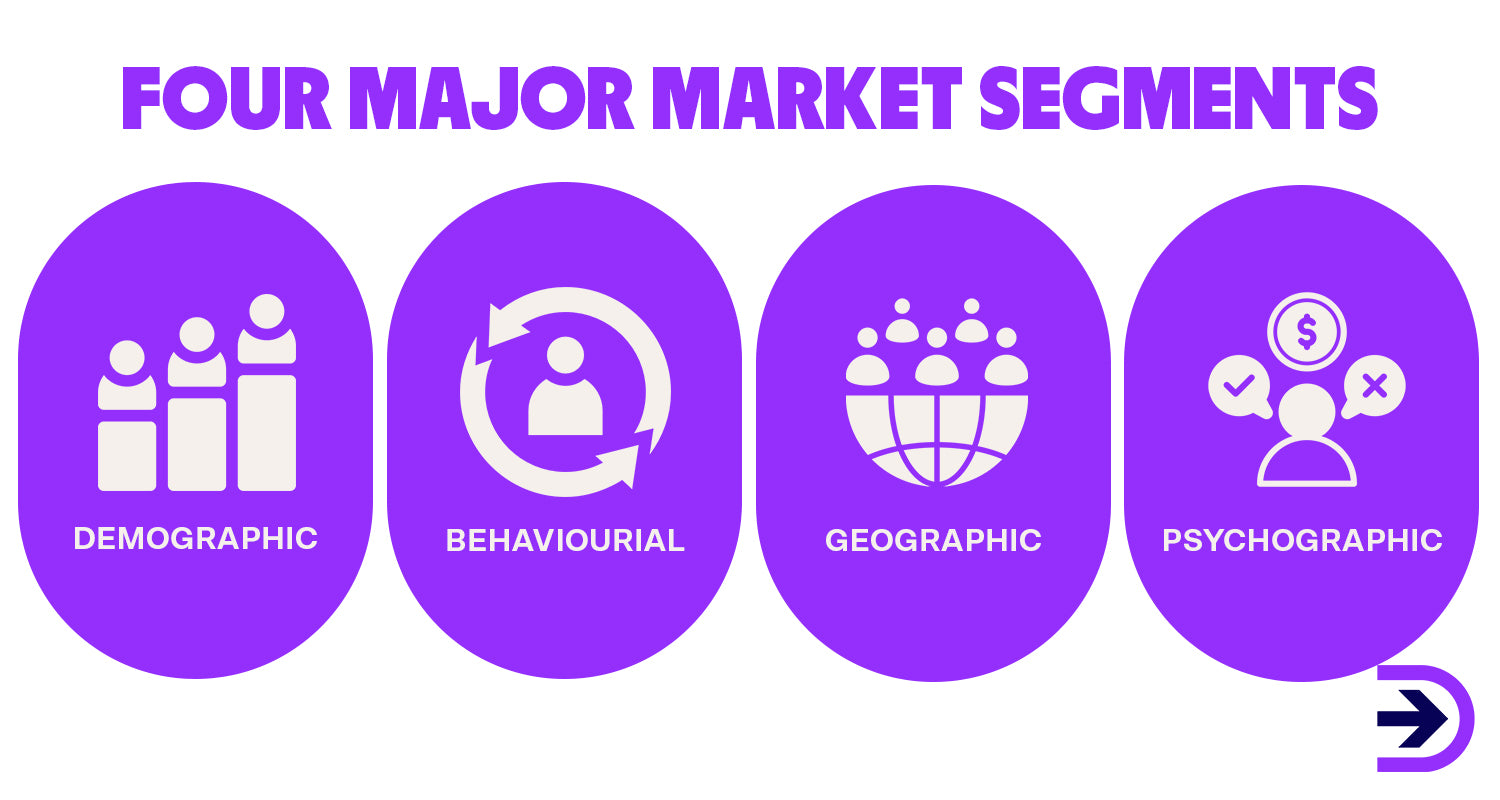
Demographic segmentation
Demographics are statistics that describe the characteristics of populations. A demographic market segment might include information about age, ethnicity, religion, sex, gender, education level or income level. It is one of the most common segmentation types as it is easy (and affordable) to obtain demographic data. You can source it from customers themselves through surveys, use data providers, or research public records.
Demographic segmentation is the best way to start examining your audience and target the right market, but you’ll often need to combine it with other information (such as psychographics) to get a clearer picture of your ideal target market.
Example of demographic segmentation
Luxury fashion brand Burberry needed a brand overhaul, and they decided to target a specific demographic with high buying power: millennials. The company recognised that the best place to find and target millennials was online, so they hired a young marketing team and began launching social media pages and campaigns. They heavily invested in their digital teams and eventually launched the first luxury social retail store in China. Shoppers use a WeChat mini program to earn social currency in-store that can be used to access exclusive content, care for a digital pet that evolves as you engage with the store, and offers store tours and product information. During this transition, their company stock was up over 250 per cent.
Behavioural segmentation
Behavioural segmentation divides consumers into customer segments based on patterns of behaviour when interacting with your company. This might include attitudes towards your brand, the types of products they consume, when they consume specific products, and why they consume them. It can happen at any point along the customer journey. Behavioural customer segmentation can be used to find your most active and engaged customers, provide more personalised experiences, and increase customer loyalty and retention.
Examples of behavioural segmentation
When you buy something on Amazon, you might see the “Frequently bought together” tab. Amazon uses an expert recommendation algorithm to analyse consumer data and determine the products you could want during or after your current purchase.
Geographic segmentation
Geographic segmentation separates your audience by location. This could be as wide as a continent, or as small as a suburb. It may also include different population densities and the type of area, whether it is urban, suburban or rural, and the local climate.
Examples of geographic segmentation
McDonalds is just one brand that nails geographic segmentation. The menus feature regional and seasonal variations for all of its locations. For example, Mcdonald's in India does not serve beef or pork products, instead offering more chicken and vegetarian options such as paneer. The McBagette wasn’t just a stunt for the hit show Emily in Paris, but a real menu item that first appeared in 2012 and was offered for a limited time. They even released potato scallops for Australians, and subsequently found themselves in hot water as states began arguing over which regional name was better: potato scallops, potato cakes or potato fritters?
Psychographic segmentation
Psychographic segmentation forms groups according to psychological traits. These include a consumer’s interests, values, lifestyle, goals, beliefs and personality. It can be used to figure out how customers feel about your brand, what their pain points are, and what will make them look at your marketing campaign.
Examples of psychographic segmentation
Barbie, the doll line produced by Mattel, is well-known for making dolls for girls, but they also produce dolls for adult collectors. In a case study by Nancy Zwiers (former Senior VP of Worldwide Marketing for Barbie and General Manager of Girls Division at Mattel), she outlines how Mattel grew their business almost 29-fold in four years by targeting both “Avid Collectors” and “Casual Collectors”. They distinguished these collector dolls by using the original Barbie script logo, higher-quality closed packaging, a new pricing strategy and new merchandising and advertising. They also augmented their sales strategy to protect the thriving resale market. These are just some of the strategies that have led to Barbie being the quintessential doll and one of the most successful media franchises in the world.
Other methods of market segmentation
Firmographic segmentation
Used by B2B businesses, firmographic segmentation separates groups by their business characteristics. This may include industry, business size, location, number of employees, years in business and products.
Generational segmentation
The audience is segmented according to the generation they belong to such as baby boomers, millennials, Gen X, Gen Y and Gen Z. This could also fall under demographic segmentation.
Value segmentation
The audience is segmented according to their economic value. This could include the customer lifetime value (CLV), the perceived value of your product to customers, or thresholds of what customers are willing to spend on yours or similar products.
Lifestyle segmentation
A type of psychographic segmentation focused on the daily habits of customers, their interests, past purchases and opinions. The Values and Lifestyle Survey Model (VALS) is a research methodology that divides your audience into eight types of consumers: innovators, achievers, thinkers, believers, experiencers, makers, strivers and survivors.
Lifestage segmentation
A type of psychographic segmentation that focuses on the different milestones or life stages such as going to school, moving out, getting a job, getting married, starting a family or transitioning into retirement.
Technographic segmentation
Segment your audience by the devices they use and the role of technology in their lives. This can be used to create personalised device-specific campaigns.
Seasonal segmentation
People have different buying preferences and priorities during holidays such as Christmas, New Year’s, Halloween and Easter. They may also buy differently across each season, such as buying swimwear to prepare for the summer holidays.
How do you action market segmentation for your business?
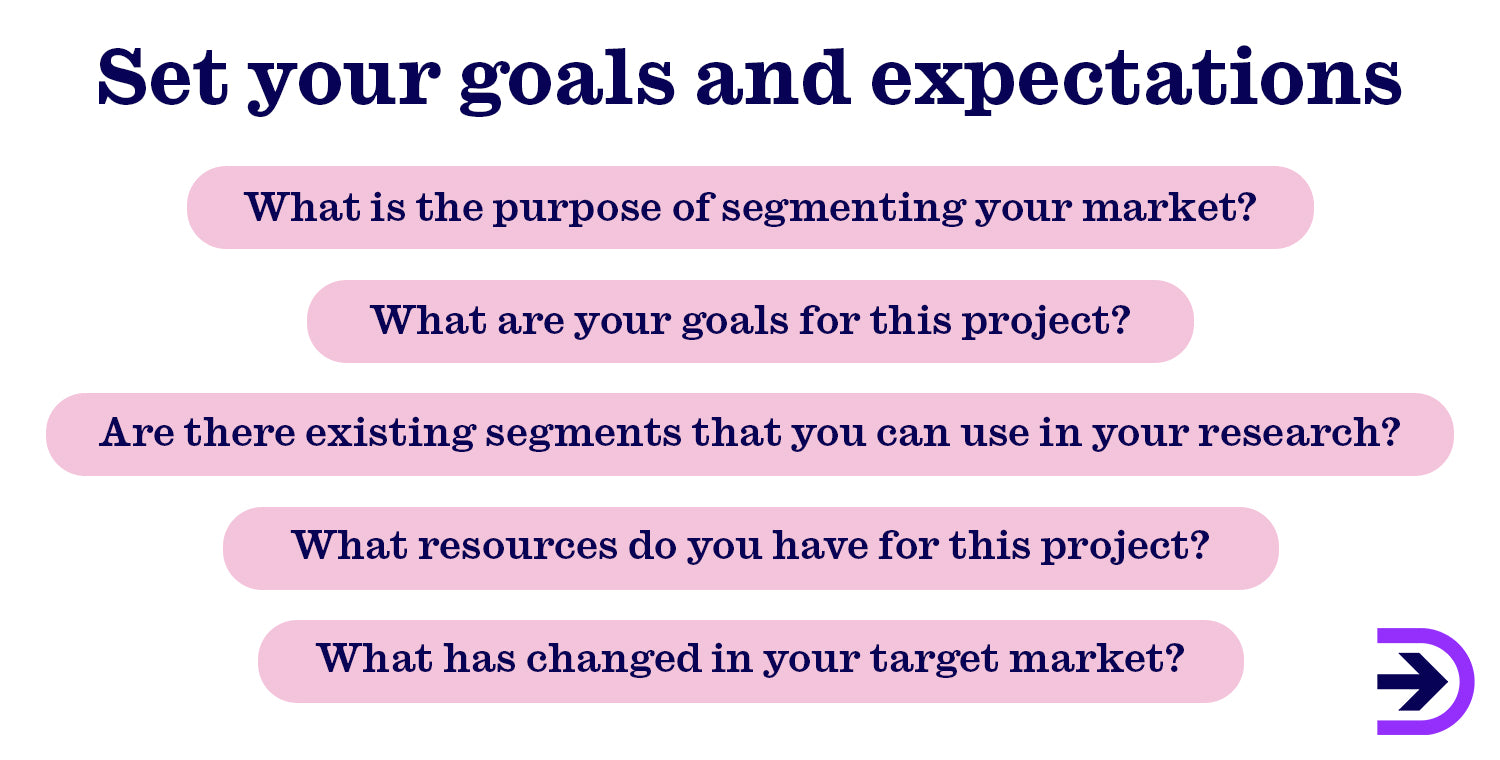
Set your goals and expectations
As with all marketing campaigns, planning is key to successful execution. Ask yourselves these questions:
-
What is the purpose of segmenting your market?
-
What are your goals for this project?
-
Are there any existing segments you’ve identified that you can use in your market research?
-
What resources do you have for this project?
-
What may have changed since you last identified your target market?
Define the market
Figure out where your business sits in the current market, the size of your target audience, and whether your product is relevant to them. Who are you selling to, are they buying from you, and where could you do better? Through this data you should be able to see certain patterns of behaviour or demographics that will assist you in the next step.
Gather data to understand your market
There are many ways you can collect data from your customers. You’ll want to collect two types of data:
-
Qualitative data: Psychographic information like customer preferences, attitudes and purchase drivers.
-
Quantitative data: Facts and statistics such as demographic information.
You can collect this information from a variety of sources including:
-
Customer surveys and polls.
-
Collected information from landing pages and lead sign-up forms.
-
Focus groups.
-
Social media insights and analytics.
-
Google Analytics or other web analytic tools.
-
Your business’ Customer Relationship Management (CRM) tools.
-
Your competitors.
-
Pricing research.
-
Sales data.
-
Publicly available data.
This data will tell you everything you need to know about your customers, including potential segments.
Decide how you want to segment
Explore and evaluate potential segments that you want to target. You might identify more than one - in fact, you should. Most brands target multiple segments, so experiment until you find the right combination to achieve your marketing goals. You might create buyer personas as a visual aid to demonstrate and relate to your segments.
Develop your strategy
Create a plan for each target segment. At this step, you’ll be deciding what a successful segmentation strategy looks like. This means establishing SMART goals, measurable KPIs and other metrics of success.
Test and monitor your strategy
You’ll need to test your marketing strategy before committing to your new campaign. Try it on a small portion of the demographic first where possible. If you see measurable results, then you can start thinking about a business-wide rollout.
Recommended market segmentation strategies
Segmentation tree
A segmentation tree is a data structure that branches out like a tree into several nodes that represent potential market segments. The overall market acts as the trunk of the tree, which then branches into the first level of segmentation. These nodes then branch off into a second level, and so on until you have your desired level of segmentation.
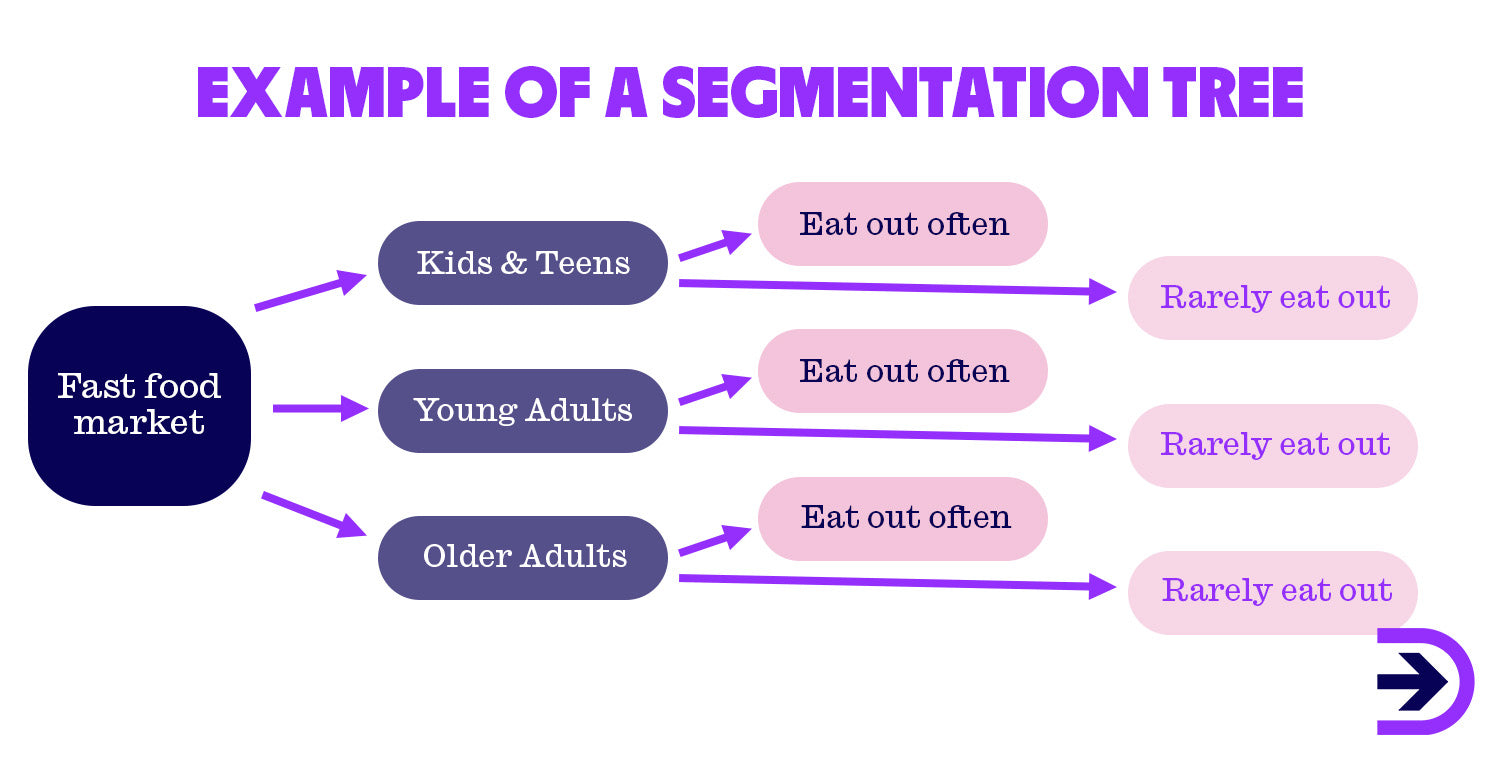
This may be a great brainstorming tool or visual aid, and will also help the segmentation process if you have trouble accessing data.
Cluster analysis
Cluster analysis is a data analysis technique that groups data sets into groups or ‘clusters’ using algorithms. There are five main types of clustering algorithms:
-
Partitioning algorithms
-
Hierarchy algorithms
-
Density-based algorithms
-
Grid-based algorithms
-
Model-based algorithms
Cluster analysis can help you find and determine your segments. For example, streaming services often use clustering algorithms to identify groups with similar watching behaviours and tailor the viewing experience and their marketing to these clusters.
A/B testing
A/B testing (aka split or bucket testing) is a randomised experimentation process where two or more variants of the same variable (such as a landing page, email campaign or thumbnail) are shown to different audiences to determine which performs better. When testing your new marketing campaign, A/B testing can help you fine-tune your approach. For example, you might show two lead sign-up pages to your site visitors: one with short copy, and one with long copy. The page that leads to the most conversions will be a clear winner.
The Segmentation, Targeting and Positioning Model (STP)
STP is a marketing model designed to focus your marketing efforts on the right audiences. Market segmentation is just one step of the process - how you use your segments is down to targeting and positioning.
Targeting is the process of choosing segments that are worth pursuing. Positioning is the process of deciding how to communicate your products and align your branding to these segments. These are separate, but equally important, parts of your marketing strategy with different objectives.
Updating your segmentation strategy
People are always changing, which means your segments are too. Changes could occur due to current affairs, advances in technology, new trends, seasonal changes or simply the passage of time. Remaining stagnant and relying on old segments will not only ruin a marketing campaign but can cost you significant time and money. When updating your market segmentation strategy, consider the following:
-
What happened between now and your last segmentation strategy that could have changed the market, and what was the driving force of these changes?
-
Why did these changes come about?
-
What are the long-term consequences of your segmentation strategy, and how can you forward-plan for these outcomes?
Your market segmentation strategy should be audited yearly, but you may also want to enact an audit during times of rapid change (such as the Covid-19 crisis) or at periodic times of the year (such as the summer holidays).
Market segmentation examples for ecommerce brands
Adairs
The Adairs Limited company owns three vertically integrated brands in the Home category - Adairs, Mocka (acquired 2019) and Focus on Furniture (acquired 2021).
Adairs targets mid to upper demographics who are house-proud and passionate about design and home decoration and offers trending products, quality staples, and value for money. Mocka is an online-only subsidiary that targets middle-market consumers including young families, and primarily deals in design-led home furniture and decor, kids and baby categories. Focus on Furniture is an omnichannel retailer targeting middle-market consumers looking for bulky furniture items.
The acquisition of Mocka was just one of Adair’s strategic investments into online channel exposure and supply chain management, a move that would inevitably help manage the Covid-19 pandemic. Sales went up by 50.2 per cent over the 2020 ownership period, even with business shutdowns in New Zealand.
Focus on Furniture’s strategic acquisition aimed to expose the Adairs group to the bulky furniture category (worth ~ $8.3 billion) both online and in-store. This provided the group with an experienced bulky goods retail management team and has and has performed well since its integration.
Since 2020, Mocka’s sales did take a hit post-pandemic as shoppers began returning to stores. Moving forward, Adair’s will be launching a series of brand partnerships tailored to their core demographic of young families, hoping to increase customer confidence and reinforce their brand position. Adairs have recognised that allowing customers to choose when and where they shop is integral to their success, and will also be implementing a physical Mocka store at some stage. With this updated strategy, Mocka’s growth could exceed $150 million in the next financial year.
Auspost
Auspost has three main target markets: personal use consumers, businesses, and enterprises/government entities. Visiting their website, you will see each audience’s page is different. Regular consumers are immediately shown a bar where they can calculate postage, book appointments, or track packages. Content includes blogs about current affairs, promotional offers, FAQs regarding delivery times and shortcuts to their online shop.
The business page features the same bar with helpful shortcuts tailored to businesses, such as price guides and printing labels. The pictures are more dynamic, showing people working a variety of jobs. Immediately Auspost offers access to the 2023 Inside Australian Online Shopping Report, offering valuable data for their audience. They show resources related to running your ecommerce business, stocking up on packaging and promoting their tools.
The enterprise page is light on advertisements but offers plenty of solutions for scalability and digital services.
Auspost also offers a tool for businesses called Campaign Targeter. It is an online tool used to plan, create and execute promotional direct mail campaigns. This tool does the hard work of collating data and allows businesses to tailor their campaigns to exact specifications. You can target a specific delivery area, lifestyle, or both. They also offer resources such as predetermined customer personas, census demographics and psychographic research. The tool is completely free…as long as you have an Auspost business account.
Auspost understands the importance of market segmentation for both its own business and its B2B audience. By offering tailored resources, they demonstrate their value as a brand and an asset.
Recommended tools/processes
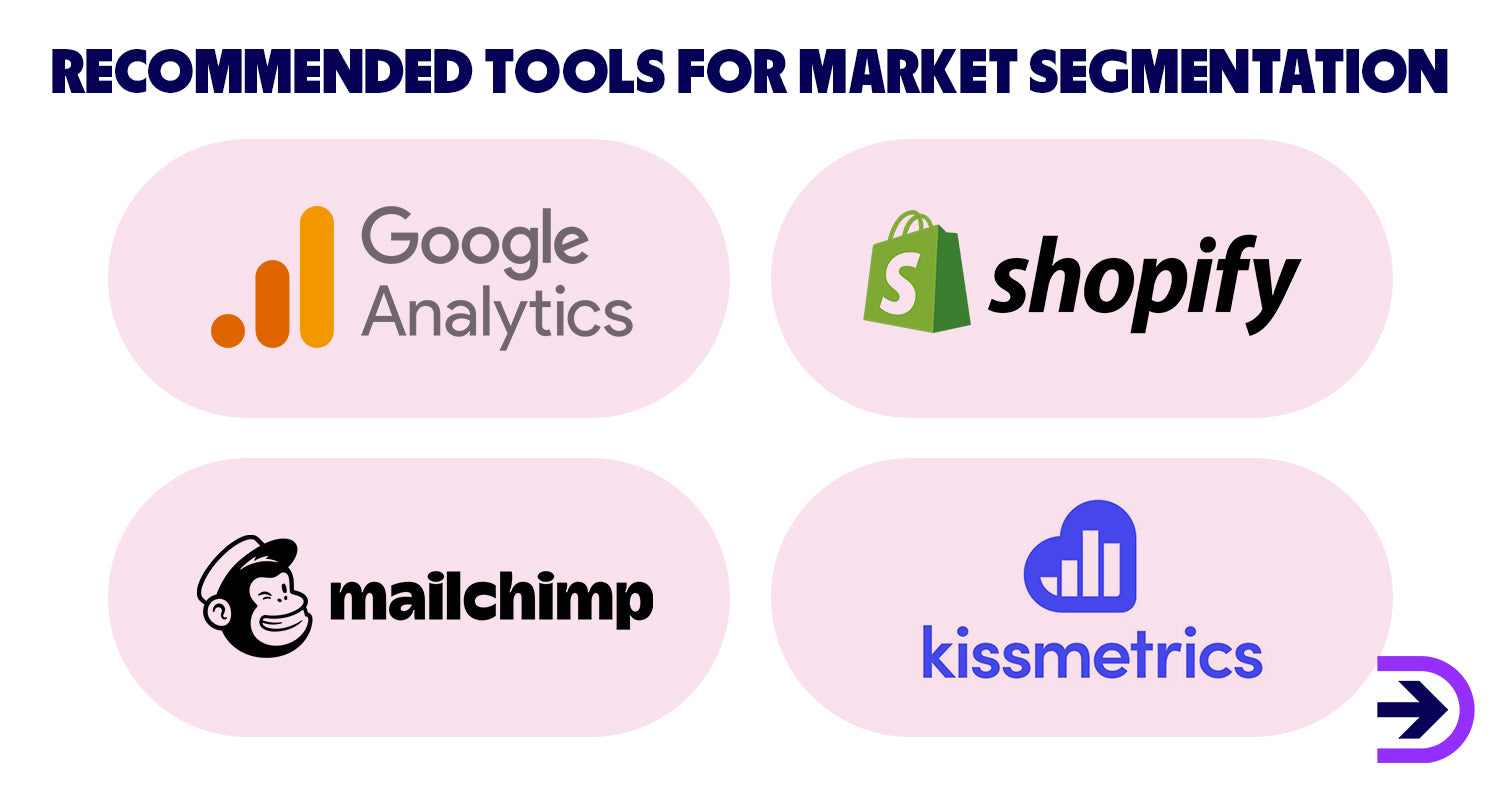
Google Analytics
One of Google’s most popular free tools, Google Analytics allows you to track site and app performance. It collects data such as how many visitors your site gets, where they come from, what they do on your site and how long they stay there. It collects vast amounts of data and generates digestible reports with valuable insights. This tool will help you determine how traffic is driven to your site, your conversion rate across different channels, your most visited pages, and your general site performance.
Kissmetrics
Where Google Analytics looks at sessions, Kissmetrics’ main selling point is their focus on behaviour-based analysis. It can help you track the customer conversion process and identify weak points, determine ROI on your campaigns, remarket to users with abandoned carts and determine which segments have the most lifetime value. It can also integrate with platforms like Facebook, Instagram, and Shopify.
Shopify segmentation tool
Shopify offers its own solution for market segmentation with this simple, easy-to-use tool. Use templates to create segments in just two clicks. Automate interactions for a variety of situations, such as customers who abandon their carts. Track custom attributes such as whether a subscriber opened an email. Target high-value customers with unique discounts. They even offer other resources such as video tutorials to better understand market segmentation and their tools.
Mailchimp
Mailchimp is a marketing, automation and email platform that allows you to create, automate and manage your email marketing campaigns. It also gives you key performance insights by tracking audience engagement. Above all, it has an extensive range of segmentation options. You can mark subscribers as VIPs for tailored content. You can segment by customer lifetime value, likelihood to purchase again, and engagement rate. You can even target predicted demographics like predicted age range and gender.
Common errors
Not enough data
Market segments are identified through patterns in data. If you’re not capturing enough data or you’re not looking at the full picture, then you won’t be able to develop an effective strategy. You also need clean data, i.e. data that has been corrected to remove inaccurate, corrupt, duplicate or incomplete data. Having clean data helps you avoid misdirection, save money on costly mistakes, and reach correct conclusions. Check your sources, make sure your data processing tools are connected where possible, and use every tool available to find relevant customer data.
Segments aren’t the right size
If your segmentation is too broad or too small, you might be wasting resources on a marketing campaign that is missing valuable consumers. Focus on relevant factors that drive your customer’s purchasing decisions. At the end of the day, you can’t appeal to every single facet of a person, but you can identify which ones will help your business grow.
Segments aren’t aligned with your business goals
When analysing consumer data, unexpected patterns and insights about your customer base may form. While these insights may be useful in some cases, it’s important you measure them up against your business needs and goals. Here are some recommended questions from Dropshipzone to help you stay on track:
-
Do these findings support the goals you laid out in the planning stage of this process?
-
Is this going to help identify leads or develop personalised marketing?
-
Is this taking away resources from the main project?
Establish SMART goals to make sure you stay on track throughout the segmentation process. These are goals that are Specific, Measurable, Achievable, Relevant and Time-based.
A stagnant strategy
Individuals are complicated and rarely fit into neatly defined categories. They’re also likely to change over time as they age, new technology is introduced, trends change, and so on. Past behaviour and past segments can’t fully predict future behaviour. Some segments might need to be scrapped over time, while others will require slight tweaking. Avoid hanging onto an inflexible strategy by not creating one in the first place - include your executive goals in the planning process and consider the future of your business, the industry, and your customers. You should be auditing your segments regularly and staying up to date with the latest industry and consumer trends.
How can Dropshipzone help with market segmentation?
We don’t just provide suppliers and retailers with expert advice, customised support and instant access to thousands of products. With our tools, you can make decisions informed by data and execute your market segmentation strategy with ease.
Dropshipzone is the low-cost, low-risk solution to reach new market segments and test your strategies. Suppliers have access to hundreds of retailers who can bring their products to new markets around the world. Retailers can choose from thousands of unique product offerings to fully cater to their audience, or expand their offerings to reach new markets. Do you find your sales dipping during the colder months? Test out a new line of products like a Devanti Portable Heater or a Jingle Jolly’s Festoon Light Set. Want to capitalise on new trends hitting the market? We’re signing up new suppliers every day with the latest product offerings to add to your store. Best of all, we have exclusive deals on new arrivals and trending products that will give your business the edge.
Sign up to Dropshipzone today and start engaging with your audience.
Market Segmentation FAQs
What is market segmentation?
Market segmentation is a marketing process that divides your market into smaller, more manageable groups. These groups may be divided using four different types of segmentation: demographics, behavioural segmentation, geographics and psychographics. You can use these market segments to identify a target market.
What is the difference between segmentation, targeting and positioning?
Segmentation is the process of dividing your market into more manageable segments. Targeting involves choosing the best segments to market to. Positioning determines where your brand sits in the customers eyes and in comparison to your competitors. These are all separate processes with the same goal in mind: to create a strong brand image and market to the right audiences.
What are the most important KPIs for market segmentation?
Conversion rate, customer churn rate, customer acquisition costs, customer lifetime value (CLV), customer satisfaction score, sales revenue, organic traffic and return on investment (ROI) are just some of the KPIs you might set for a market segmentation strategy.



